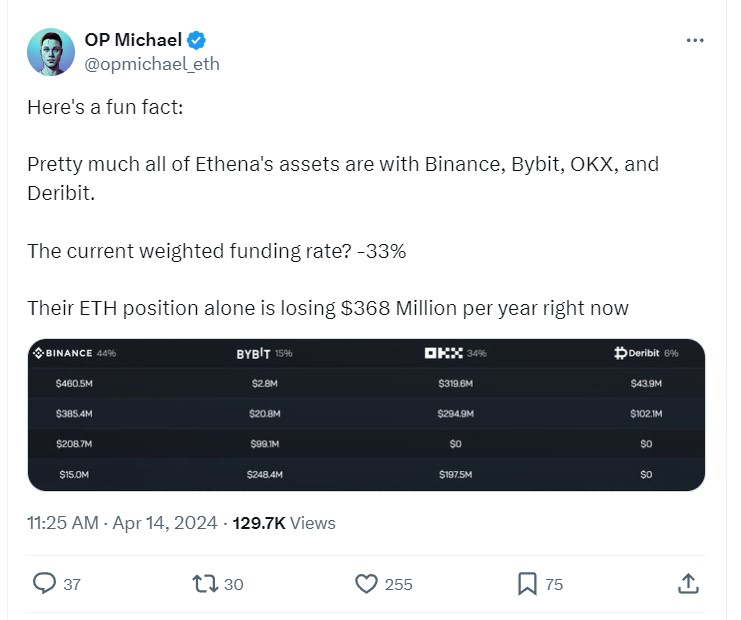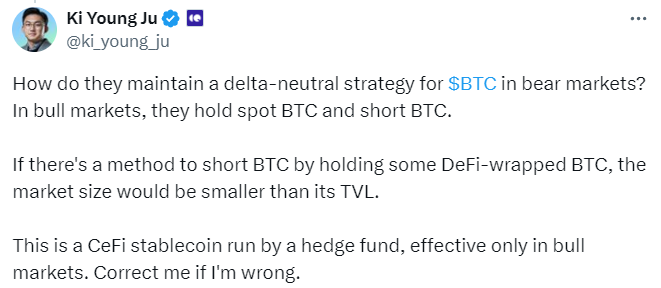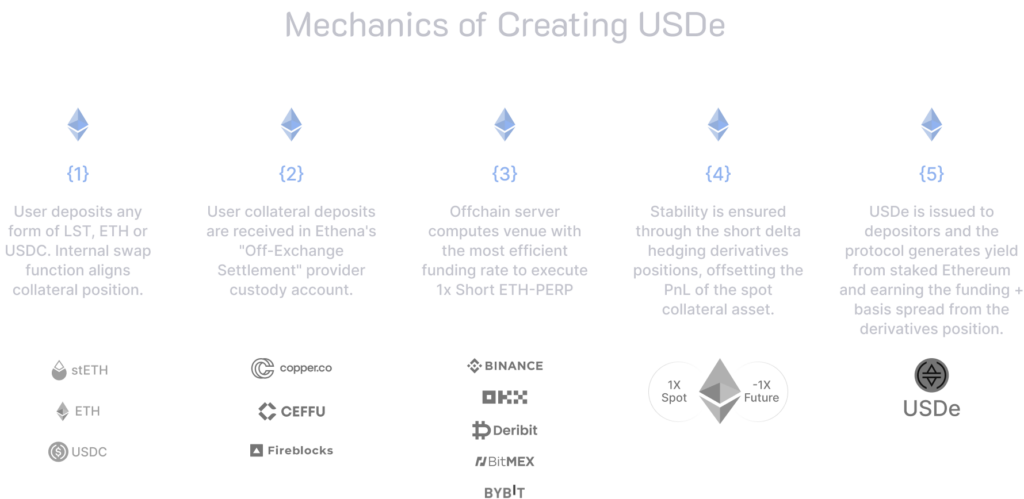Ethena Labs’ new stablecoin topped $2 billion in market cap faster than any other dollar-pegged asset in crypto’s history. But USDe’s meteoric rise has sparked fears that it might repeat the high-profile collapses of other stablecoins.
While its attractive yield of 17.2% has drawn frequent comparisons to Terraform Labs’ disastrous stablecoin UST, it’s really nothing like UST, which had the circular backing of its own token, an algorithm, and a few hopes and prayers.
Ethena distances itself from such predecessors by marketing its stablecoin as a “synthetic dollar.”
To mint the USDe synthetic dollar, users deposit Bitcoin, Ether, Staked Ether (stETH) or USDT into the protocol, which is used to open equivalent short perpetual positions or derivatives contracts with no expiration date.
If the price of the asset goes down, it’s balanced out by its 1:1 futures position, mitigating losses. If the collateral appreciates, it is counteracted by the falling value of the short position.
This design, often referred to as “delta-neutral,” has been battle-tested for decades as a variation of the cash-and-carry trade in traditional finance, according to Justin d’Anethan, head of APAC business development at Keyrock. It is considered safe under favorable market conditions.
But what happens when the pendulum swings the other way?
Experts share with Magazine the tests Ethena must pass to prove its resilience under market stress.
Negative funding rates risk
Ethena has been able to offer high yields thanks to the crypto market’s hot streak.
Fewer investors are willing to bet against rising crypto prices, allowing short futures investors like Ethena to collect regular checks from long contracts in the form of funding rates and pay out USDe yield.
Funding rates in perpetual futures align contract prices with the underlying asset’s spot price, avoiding significant deviations.
In bull markets, high demand for long positions can push their prices above the spot, triggering a positive funding rate. Long holders then pay fees to short holders, moderating this rise and realigning prices with the spot.
Conversely, in a scenario where short positions cost more than the spot price, the funding rate becomes negative, and short holders pay long holders, reducing shorts and lifting prices toward the spot.
Traders facing steep funding rates must decide if potential profits justify the costs. If not, closing their positions helps stabilize contract prices with the spot.
Ethena’s strategy “thrives” in bullish conditions, explains Julia Palamarchuk, co-founder of Aqua Protocol on the TON network, which is developing its own stablecoin backed by liquid staking tokens (LST).
The tables turn in a bear market when Ethena will be forced to pay funding rates to long position holders.
“Short positions [become] costly to maintain, potentially leading to a deviation from the $1 peg if costs escalate beyond manageable levels, Palamarchuk tells Magazine.

Ethena can pay the fees through the yield received from the LST in its collateral, stETH — an Ether-pegged IOU token that is given to those that use Lido DeFi protocol for Ethereum’s validator staking.
Ethena’s website shows that stETH accounts for 16% of its collateral, the lowest share among the list of four that includes Ether, Bitcoin and the stablecoin USDT.
The stETH yield alone, which currently has an annual percentage rate of 3.3%, may not be enough to cover the entire project in times of sustained negative funding rates.
As markets crashed over the weekend in response to Iran’s attack on Israel, the funding rates went seriously negative. USDe briefly wobbled off its peg to $0.995 on April 13 but Seraphim Czecker, Ethena’s head of growth said the following day “So far so good: USDe passed its first stress test.”

Ethena doesn’t expect to encounter extended periods of negative funding rates too often.
Citing internal analysis, Ethena founder Guy Young told Cointelegraph in a February interview that in 2022, which was a bearish year, the average funding rate was zero. He added that the worst periods involved a week of negative funding close to minus 3%.
“If the interest rate is too low, that’s just the market telling us that the supply of USDe is too high relative to leverage demands in the system more broadly, and it means we need to shrink,” Young said.
The invisible hand of the market can also play a role in keeping the USDe pegged during market catastrophes. To protect their own interests, users must redeem their USDe, which lifts the shorts, contributing to funding rates rebounding.
Ethena also keeps an insurance fund that holds $32 million.

“There is no zero-risk set-up in any traditional financial markets, and definitely none in decentralized financial markets,” says Keyrock’s d’Anethan.
“The variation [of the cash-and-carry trade] used by Ethena makes sense and should guarantee stability along with a yield that will vary depending on how in demand derivatives are, so it might not remain as high as it is now but shouldn’t pose serious problems.”

Centralized counterparty risks
A string of cryptocurrency exchanges have imposed withdrawal freezes or become insolvent in recent years, which means USDe’s reliance on centralized exchanges for its derivatives model raises big concerns.
Ethena partly alleviates this risk by tapping into off-exchange settlement custodians.
These businesses safeguard investor assets for Ethena in their vaults, and use it to open a perpetual position at a centralized exchange on their behalf.
If a centralized exchange faces insolvency or other risks, Ethena’s perpetual position will close, but the collateral assets themselves should be safe as they were never in the exchanges to begin with.
But that’s only half the battle: if the derivative position isn’t moved to another exchange, it could pose a risk to the stablecoin’s peg.
“Ethena’s current centralized operating model, involving centralized wallets for fund management, introduces significant risks related to security and contradicts the decentralized ethos of DeFi,” Palamarchuk says.
Jaewoo Cho, an assistant professor of social science at South Korea’s Hansung University, has conducted on-chain analysis on the movement of wrapped Ether (wETH) from Ethena’s mint and redeem address to its custodians and found that a “significant amount directly goes to an exchange.”
According to Cho’s analysis, 11,417 Ether from Ethena’s mint and redeem contract went directly into Bybit.
“While [Ethena] may claim custodianship mitigates risk, in reality, the trust issue cannot be avoided,” Cho tells Magazine.
A spokesperson for Ethena tells Magazine that the transactions seen by Cho are part of a prelaunch phase that tested address flow before launch.
“Backing assets that have entered Ethena since going live with the public mainnet have all been routed directly to an off-exchange solution,” Ethena says.
Cho adds that most of the USDT he traced went into just one custodian, Copper.
“It makes it seem like the risk is not well-diversified,” Cho says.
Ethena released its custodian attestations Monday, reporting on the locations of the collateral assets backing the 2.359 billion USDe supply: Copper holds $1.28 billion, Ceffu has $1.07 billion, and Cobo keeps $4.87 million.
Ethena’s derivatives model could limit supply
USDe is the fastest-growing stablecoin to date. But there are some limiting factors that make it less likely it could catch up to its centralized counterparts like Tether, which boasts a market capitalization of over $100 billion and often outranks Bitcoin in daily trading volumes.

“The derivatives market’s size and the maximum open interest limits on exchanges could cap USDe’s growth potential, making it unlikely to surpass the popularity of fiat-backed stablecoins,” says Palamarchuk.
Ethena’s growth, as a synthetic dollar, hinges on the perpetual market size.
A rising USDe market cap boosts short positions in derivatives as such contracts are opened to mint USDe, pushing negative funding rates higher. Theoretically, this reduction in profits prompts investors to close shorts and liquidate USDe.
If USDe’s volume gets too big for long positions to stabilize funding rates, Ethena’s expansion could be restrained.
Ethereum open interest is valued at $9.75 billion as of April 11, and 12% of that helps stabilize USDe, according to Ethena.
If the USDe is embraced, then it could lead to a “large growth” in the derivatives open interest, according to Arthur Hayes, who introduced the “synthetic” dollar concept last March.
Ethena addresses scalability limitations by expanding on collateral assets, most recently adding Bitcoin.
Bitcoin’s open interest market is larger than Ethereum’s, with $37 billion on major exchanges, CoinGlass data shows.
But that in itself brings new challenges on its own.

Unlike stETH, Bitcoin does not yield native staking returns. Neither do its other collateral assets, USDT and Ether.
While it can still achieve a delta-neutral position when the spot price drops thanks to the equivalent short position hedge, the lack of a staking yield means its cushion to soften the blow from negative funding rates is thinner compared to other collateral assets like stETH.
This could force Ethena to tap into its insurance fund.
The project’s reserve is largely funded by its derivatives earnings that is considered excess due to USDe holders opting to hold the asset over staking it to earn yield.
Out of the $32 million in insurance reserves, Ethena holds $6.1 million, of which $5.1 million is in USDT and $1 million in its own USDe, parked in its wallet. It also has $15 million sDAI at Maker and $11.3 million worth of USDe and USDT pairings on Uniswap.
Having DAI in its reserve fund doesn’t directly threaten the USDe itself, but the value of the insurance could pose risks. That’s because MakerDAO recently passed a vote to raise the debt ceiling to $1 billion to invest in USDe, creating an awkward situation where both stablecoins may be required to defend each other in catastrophic scenarios.
MakerDAO has received heavy criticism for its move, including from DeFi protocol Aave, which decided to reduce DAI collateral.
“In the scenario where Ethena uses DAI in its insurance fund, and both Ethena and MakerDAO face market downturns, the interdependency could indeed pose risks,” Palamarchuk says.
She adds that DAI’s overcollateralization provides a buffer of extra assets needed to maintain its peg.
A separate issue is that stETH can also lose its peg to Ether, as it did in 2022. However, experts Magazine speak with agree that stETH deviation is not a realistic threat to Ethena’s USDe.
“If stETH loses its peg because they’ve set up positions, it should neutralize the delta, so there shouldn’t be much impact,” Cho says.
Being the new kid on the block, Ethena has to carry the heavy baggage of past stablecoin failures with it, but experts claim that the possibility of a depeg is less likely.
“Aside from operational mishaps or execution error, the trade itself is virtually risk-free,” says d’Anethan.
He adds that users must balance the existing risks, such as custodial risks and market conditions, against the “convenience and attractiveness” of the stablecoin and its yield.
week.

The post The real risks to Ethena’s stablecoin model (are not the ones you think) appeared first on Cointelegraph Magazine.

